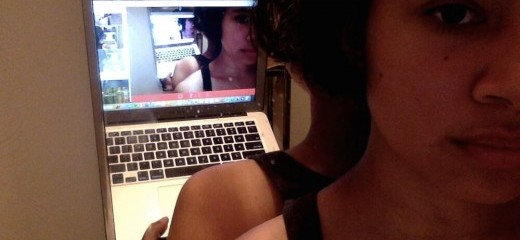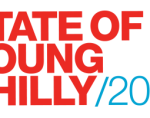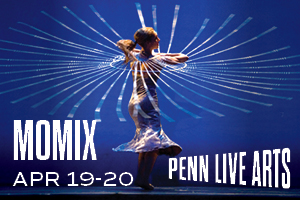
Holding Dance Institutions Accountable: An Interview with Amalia Colón-Nava
by Mira Treatman
Responses to the recent deaths of George Floyd, Breonna Taylor, Ahmaud Arbery, and too many others, have varied across race, class, and other intersections. These include Gregory King’s recent article on tD that highlights the dance world’s “deafening silence” to these injustices.
Dancer and maker Amalia Colón-Nava has recently responded to some of the deafening silence in Philadelphia by using Instagram as a platform for calling out white supremacy and complicity. She chose to include thINKingDANCE in her string of Instagram call-outs. In addition to tD responding on Instagram, I decided to also give Amalia this platform to share her thoughts. Amalia took the time to speak with me over Zoom, and the following are edited excerpts of what I hope is the start of a longer conversation about how to make our community a just one.
Mira Treatman: How do you situate yourself as a person in the world? As an artist?
Amalia Colón-Nava: I’m always reflecting and questioning how I situate myself in the world. Right now it’s really different than how I would have described myself a few months ago. I don’t ever want to feel like I’ve reached the full potential of who I can be as an artist or a person.
MT: How were you spending your time before the pandemic, and what have you been doing more recently?
ACN: Before the pandemic, wow that’s a lifetime ago! I was working at Milkboy, and I was dancing a lot—freelance work. I was spending time at The Whole Shebang where I had an exchange with them, admin work for studio space. I was spending a lot of time at Urban Movement Arts for classes and rehearsal. Now I have shifted. I don’t take class very often. I meet with choreographer Lily Kind and with MoDa, Christine Morano’s project. I was unemployed right away because Milkboy closed, so I was able to file for unemployment as soon as the pandemic started, which was really great. My job talked me through it, and I was able to get money within a month of being unemployed. Then I started working at Evelyn Langley’s farm three to four days a week. Evelyn, who is also a dancer, rents ten plots of land at the Schuylkill Environmental Education Center. She runs a small CSA on that land, and I help her with it. We have an exchange where I get a tiny stipend and food, and I get to learn a lot about farming. I had no previous experience, but I grew up around a lot of plants. My dad, who is a biochemist, had a lot of gardens, and I helped him as a kid. I think of the work I do on the farm as a creative practice.
MT: Is the physicality of the farm work new to your body?
ACN: It’s really different. I definitely need the dance to balance it out. It’s a lot of squatting, being on my knees pulling weeds—the same thing over and over again. Recently, I’ve been able to take off my shoes, which feels more like dancing. There’s something about having more articulation in my toes that makes the farm work feel embodied.
MT: When you got in touch with thINKingDANCE over Instagram—first, thank you for doing that. You shouldn’t have to be spending your time doing that, and I appreciate that you did. Would you like to share more about your social media activism?
ACN: It came from the impetus of my UArts classmate Janeill Cooper, @jayymac_ on Instagram. She had done call-outs to big New York institutions. It was incredibly compelling, the way that she was asking these questions that I honestly had asked my whole life. Janeill took the lead from Nina Chinara's "An Open Letter to Arts Organizations." I’ve also been inspired by the recent actions of Nina Chinara and The Dance Union Town Hall. It feels incredibly empowering and affirming to hear people like Nina Chinara and other testimonies in The Dance Union Town Hall express these issues. I empathized with everything that Janeill was saying. It was after we all saw the video of George Floyd. This really felt like a breaking point. People were like, “no more.” We cannot stand for this anymore. I feel like this, too, for the dance environment.
It’s incredibly frustrating that the dance community is supposed to be leading conversations around race and of a better world we can imagine. And it’s doing the opposite. Dancers are here trying to be the leaders of open thought and conversation. We have nothing to lose, and we’re not leading the conversation. It really stems from the institution, not the artist. We’re complacent. I think that thINKingDANCE is a great organization. I also know Maddie Hopfield (tD writer and Instagram producer), and I have so much respect for her responding to me right away. It’s also a tiny, underfunded organization that’s going through COVID. thINKingDANCE is not the target for the social media instigation, I guess, not at all.
MT: When you did that wave of instigations on social media, did you get responses from anyone other than thINKingDANCE?
ACN: No, not really, no one else responded. I also tagged Urban Movement Arts, which I regret. A really great conversation came out of it, though. I included them because I know them and I felt okay talking to them about it. The Wilma Theater had one of the better responses, in my opinion. I would have wanted to see more from FringeArts.
MT: I guess because thINKingDANCE responded both by Maddie Hopfield on Instagram and by this interview, I’m surprised other places didn’t.
ACN: …and you’re the smallest with the least resources!
I have been on social media in the last two weeks so much more than I am normally used to because it’s my way of keeping in touch with all the discourse around protests and what to do and where to go. The call-outs were my first response to the momentum, to the George Floyd tape coming out, and to the protests and outcries that happened right away. Since then I’ve gotten more involved in the overarching issues. It’s a lot easier now to take action. We’re seeing organizers ask for something specific from our City Council members, and there’s a way for us to push for that.
I don’t want to let go of the conversation around what we are doing to hold our dance institutions accountable. I just can’t get away from that. If we’re asking for funding, because arts and culture does something for communities, what communities is it serving?
MT: Do you mean the city arts budget for the Philadelphia Cultural Fund and the Office of Arts, Culture, and the Creative Economy which Mayor Kenney proposed to reduce to zero?
ACN: Yes.
MT: Can you speak more about what using government funds for “community” means?
ACN: I just come back to: Who is watching the dance? Who is benefitting from the dance? Who is the dance for? Who does it represent?
MT: Yes. I often notice navel gazing in the dance environment. There’s only so long one can sit in that suffocating echo chamber. Time is of the essence. What do you feel is the intersection of time and artistic labor?
ACN: If society valued the product based on the process—meaning how the art is made, and who is involved in the making, who it is serving, who is responding to and being inspired by art—then the energy and time spent is distributed in a totally different way. Art doesn’t need to be as large scale as it used to be. Maybe it can never be global because it is only trying to be in conversation with the communities that inspired the artist to create the art in the first place. I also think this question highlights a big difference between art that is tangible, something you can buy and have in your home, and performance art, which is fleeting. But in a world where money is obsolete, if you challenge yourself to think about trading time, perhaps there is an answer to that question.
MT: To what extent is your action of an Instagram call-out part of your performing life during COVID?
ACN: In a time when social media has the potential to be so much, either so detrimental to your mental health or so inspiring, I’ve been trying to be more conscious by asking the same questions that I ask in my art practice: Who am I posting for? Is it for myself? Is it for family members who don’t see me that often who want to know what I’m doing? Is it for friends to be uplifting? Or for this mass of followers made up of people I know and don’t know. With the algorithms, you don’t really know who’s seeing what. It’s a big question. It’s directly correlated to an art practice.
A few days later, Amalia followed up with me in an email to share the following.
ACN: I picked up this work because it is not one person's job. It is all of our jobs to hold each other accountable. You don't have to be special or have experience or be an expert to do this. It can be as simple as noticing the institutions and environments that you work in. Who is there? Who is being represented? If there are people missing, talk about it! Bring it up with whoever is in charge. Ask why there are no Black and Brown people around you. It is uncomfortable, but it is necessary if we are to dismantle the deep rooted white supremacy in dance (and other arts) institutions. If enough people start doing this, the pressure can be taken off those who shouldn't have to do it in the first place. This is why I posed this question to you and other dance organizations, in an effort to spread the load. To me this seemed obvious, which is why I didn't bring it up, but I'm realizing that I don't think we talked about how this can directly translate to an action step for readers.
Interview with Amalia Colón-Nava, June 12, Zoom.
By Mira Treatman
June 22, 2020





.png)


